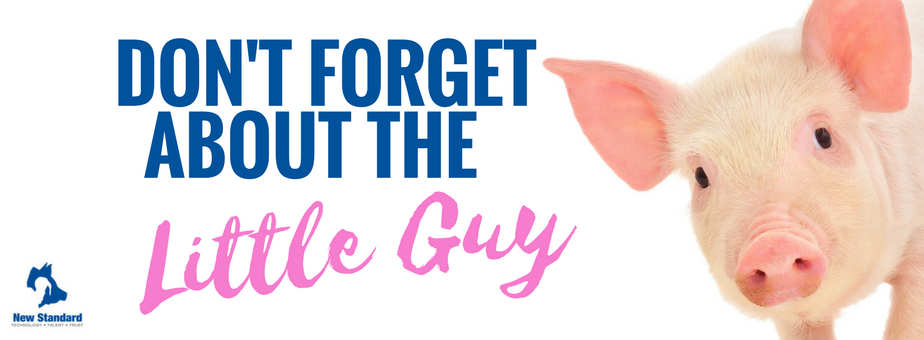I know we spend a lot of time sharing information about the care and housing of sows; so much so that sometimes we may appear to lose sight of the bigger picture. Which in this case is actually the little picture. If great care for the sows is important, and increased production is the result, then it stands to reason that once you have done all of that you also need to focus on what you’re going to with all those little piglets.
It doesn’t matter if you are an ISO-wean barn selling your piglets or are responsible for feeding them to market, the job just gets started once they are born. So let’s look at a few things that can be done to ensure that the little guy has the best chance possible.
Feed The Mamas Well, Feed the Babies Well
This little piggy had roast beef, this little piggy had none…
We all know the nursery rhyme, but did you ever consider how unfair it is that one got to eat and the other didn’t? Although I’m sure no one would recommend feeding your piglets roast beef, proper nutrition is key for your piglets to get a good start.
There are a great many products available for early nutrition (and some of them actually are great), but there really is no replacement for a mother’s milk. And for the sow to produce enough milk she needs to have the proper nutrition. One of the tools that can help with feed intake on lactating sows is the Nedap Farrowing Feeder. Basically it automates the feeding to each farrowing crate based on a curve designed to meet the needs of each individual sow and her piglets.
Barns that implement these feeders have shown us that you can get 500 grams (1.1 lbs.) more weight on each piglet at weaning. Industry experts have suggested that weaning weight can be multiplied by 9 to give you an estimate of the extra weight you should achieve by market. So those 500 extra grams at weaning make for 4.5 kgs (9.9 lbs.) extra shipping weight; and more money in your pocket.
Managing Sickness Starts with Your Building Materials
Uh oh...I don’t feel so good...
Anyone with kids has heard this line, and once it’s spoken you know that you're in for a rough ride. But what if you could prevent the sickness in the first place? You already know that it is vital to keep a farrowing room as clean as possible to help avoid disease, so you wash and disinfect. But are you really getting it clean?
We've found that PVC panels can be very misleading. After they are washed the surface looks clean, but in reality PVC is a porous material that allows viruses to remain beneath the surface (not to mention the nasty mess that exists inside the plank). Our solution is using PanelTIM plastic panels which are made from polypropylene. Polypropylene is non-porous, so you can be assured that once you have washed the room, you have not left behind any bugs just waiting to come in contact with the next little guy.
Everyone Needs Some Elbow Room
Genetic improvements and other factors have continually pushed up the number of piglets born to each sow, but in many cases the design and space allotted to those litters has not kept pace. A properly designed farrowing crate will assist in preventing pre-wean mortality, but something that tends to get forgotten is the creep area.
It may seem obvious that more pigs need more space but I have seen too often where a producer does not have the proper amount of creep space to accommodate the size of litter that is occupying it. I do recognize that the farrowing is the most expensive area of a barn to build so the tendency is to try and limit that space, but if they do not have enough space to freely move around (and stay out from under the sow) then you will be fighting an uphill battle with pre-wean mortality. We recommend farrowing pens be a minimum of a 6’ wide x 8’ long, as this will allow space on both sides and behind the sow for the piglets to move around.
Don't Forget the Data
So you’ve done everything right in the farrowing room and you have a large batch of healthy pigs that are ready to be weaned. If you are selling weanlings, your job is pretty much done, but for anyone raising market hogs you've got a ways to go.
Since your FCR (feed conversion ratio) is the main factor in deciding if you are going to be profitable or not, it is worth your time to fully understand your numbers before your little piggies go to market.
We have done other articles about data being so important in sows, but that is no different throughout the growth stages of all pigs. There are now scales available (we use PigScales) for monitoring growth in a nursery barn that can give you real-time information about your pigs, allowing you to not only ensure they are performing well, but also do in-barn trials to find YOUR best results come market time.

To put it simply, it is insane to skip evaluating and assessing your farrowing and nursery barn processes. If there is industry-proven technology and support to help you understand the trends in your barns, it makes sense to use it—not just for your sows, but for the little guys too.






